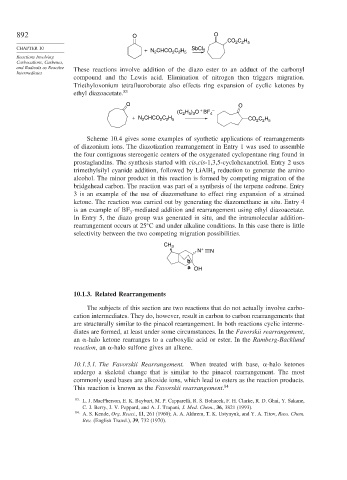Page 916 - Advanced Organic Chemistry Part B - Reactions & Synthesis
P. 916
892 O O
CO C H
2 2 5
CHAPTER 10 SbCl
+ N CHCO C H 5
2 2 5
2
Reactions Involving
Carbocations, Carbenes,
and Radicals as Reactive These reactions involve addition of the diazo ester to an adduct of the carbonyl
Intermediates
compound and the Lewis acid. Elimination of nitrogen then triggers migration.
Triethyloxonium tetrafluoroborate also effects ring expansion of cyclic ketones by
ethyl diazoacetate. 83
O O
+
(C H ) O BF 4 –
2 5 3
+ N CHCO C H CO 2 2 5
C H
2 2 5
2
Scheme 10.4 gives some examples of synthetic applications of rearrangements
of diazonium ions. The diazotization rearrangement in Entry 1 was used to assemble
the four contiguous stereogenic centers of the oxygenated cyclopentane ring found in
prostaglandins. The synthesis started with cis,cis-1,3,5-cyclohexanetriol. Entry 2 uses
trimethylsilyl cyanide addition, followed by LiAlH reduction to generate the amino
4
alcohol. The minor product in this reaction is formed by competing migration of the
bridgehead carbon. The reaction was part of a synthesis of the terpene cedrene. Entry
3 is an example of the use of diazomethane to effect ring expansion of a strained
ketone. The reaction was carried out by generating the diazomethane in situ. Entry 4
is an example of BF -mediated addition and rearrangement using ethyl diazoacetate.
3
In Entry 5, the diazo group was generated in situ, and the intramolecular addition-
rearrangement occurs at 25 C and under alkaline conditions. In this case there is little
selectivity between the two competing migration possibilities.
CH 3
N + N
b
a OH
10.1.3. Related Rearrangements
The subjects of this section are two reactions that do not actually involve carbo-
cation intermediates. They do, however, result in carbon to carbon rearrangements that
are structurally similar to the pinacol rearrangement. In both reactions cyclic interme-
diates are formed, at least under some circumstances. In the Favorskii rearrangement,
an -halo ketone rearranges to a carboxylic acid or ester. In the Ramberg-Backlund
reaction,an -halo sulfone gives an alkene.
10.1.3.1. The Favorskii Rearrangement. When treated with base, -halo ketones
undergo a skeletal change that is similar to the pinacol rearrangement. The most
commonly used bases are alkoxide ions, which lead to esters as the reaction products.
This reaction is known as the Favorskii rearrangement. 84
83 L. J. MacPherson, E. K. Bayburt, M. P. Capparelli, R. S. Bohacek, F. H. Clarke, R. D. Ghai, Y. Sakane,
C. J. Berry, J. V. Peppard, and A. J. Trapani, J. Med. Chem., 36, 3821 (1993).
84
A. S. Kende, Org. React., 11, 261 (1960); A. A. Akhrem, T. K. Ustynyuk, and Y. A. Titov, Russ. Chem.
Rev. (English Transl.), 39, 732 (1970).

